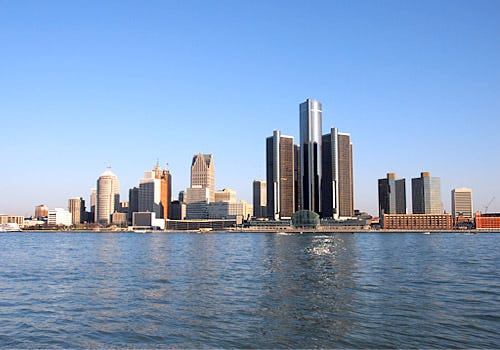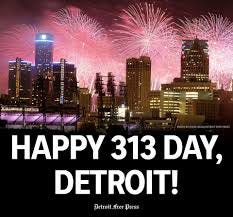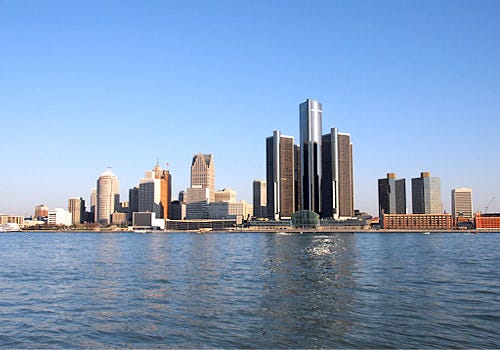The City of Detroit skyline as seen from across the Detroit River in Windsor, Ontario Canada.
The City of Detroit was founded on July 24, 1701, as a trading post and fort by Antoine de la Mothe Du Cadillac, a French trader and explorer. Fort Ponchartrain was located near the Detroit River that has Canada on its other side. “Detroit” is actually a French word that roughly means “strait.”
So although July 24 is our official anniversary date, in the last few years we have also adopted March 13 as our other celebration day. March 13 was chosen because the telephone area code for Detroit is “313” and March 13 is abbreviated “3.13.” Makes perfect sense, right?
Detroit has a very long and storied history, with both good and bad events and incidents happening in the past 321 years. In October 2021, prominent educator and historian Jamon Jordan, founder of the Black Scroll Network and Tours, was appointed as Detroit’s first official historian. He is the go-to person for any and all of Detroit’s history.
That said, I’d like to feature five lesser-known facts about my beloved hometown, and invite you to come and visit us someday soon!
Larger than NYC
Belle Isle, Detroit’s first city park that actually is an island opened in the 1880s and was designed by Frederick Olmstead, who also designed New York’s Central Park. Belle Isle is larger than Central Park.
Campus Martius Park, located in downtown Detroit, is a public-square type park and gathering spot that opened in 2004 at the exact spot where the expansion plan for Detroit was initiated in 1805 by Augustus Woodward. Campus Martius has a skating rink in the winter that is larger than Rockefeller Center in New York City.
Detroit Automotive Firsts
Speaking of Justice Woodward, Detroit laid the first-in-the-country concrete paved road along M-1 (Michigan state road 1). That paved road was named after Justice Woodward, and Woodward Avenue now extends from downtown Detroit to Pontiac, Michigan.
Detroit also installed the first urban highway that goes crosstown through Detroit and Highland Park. The Davison Freeway is a six-lane, limited-access highway that is still in use.
The first Ford Model T car was built at the Ford Piquette Avenue Plant in Detroit. The first moving assembly line plant was built in Highland Park, a city completely surrounded by Detroit, on Woodward Avenue.
Detroit was a center for the Abolitionist and Civil Rights Movements Because of our location right across the Detroit River from Canada, Detroit was one of the last stops on the Underground Railroad.
The Detroit Anti-Slavery Society was formed in 1837, the same year Michigan became a state with a ban on slavery. Prominent Black citizens in the 19th century helped people escape to Canada and also worked to elevate the status of Black people overall in the south and in the north. Abolitionist John Brown held several meetings in Detroit.
Detroit was also active in the Civil Rights and labor rights movements, starting in the 1930s and 1940s. In 1963, Dr. Martin Luther King, Jr. gave the initial version of his “I Have A Dream” speech during the June 23, 1963 March for Freedom down Woodward Avenue, attended by over 125,000 people.
The Influence of Detroit on the International Music Industry Just about everyone knows that Detroit was the beginning of Motown, but Detroit has a very rich and varied musical history. Besides Motown, Detroit birthed two other International music genres, punk rock, and techno.
Due to the large number of Black people who came up north to Detroit during the Great Migration, Detroit became known as a harbinger of Black music, including gospel, blues, jazz, R&B, and rock-and-roll. The near east side of Detroit, including Black Bottom and Paradise Valley, was a major entertainment district for Black performers. In the 1940s and into the 1950s, those Black areas of Detroit were intentionally obliterated by “urban renewal” projects and new freeways.
Detroit also has a long and storied history for classical music and theater.
The Detroit Symphony Orchestra was revived in 1918 and is one of the largest international symphony orchestras.
Detroit has the 2nd-largest theater district after New York City, including more than 30,000 theater seats and over three dozen theaters.
In 1964, Dr. David DiChiera began to build an opera company that began as an arm of the Metropolitan Opera in Detroit. In 1973, the company became formally known as the Michigan Opera Theatre (MOT), performing at the Music Hall Center for the Performing Arts located near downtown Detroit. In 1966, the Detroit Opera House, previously known as the Grand Circus Theatre, reopened after extensive renovations and is home to the now-named Detroit Opera, world-renowned dance companies, and Broadway shows and concerts.
More Detroit Firsts and Seconds So many people have negative perceptions about Detroit, but those interpretations are slowly but surely disappearing. Although the City of Detroit is no longer the 5th-largest city in the United States, the history, influence, and importance of Detroit and its surrounding areas are hard to match.
Detroit’s Marriott Hotel at the Renaissance Center was the country’s tallest hotel until Marriott built a hotel in midtown Manhattan that is only 23 feet taller.
Until the Smithsonian African-American History Museum opened in 2018, the Charles A. Wright Museum of African-American History was the largest museum of its kind in the country.
The metropolitan area of Detroit, known as Metro Detroit, is the 2nd-largest metro area in the Midwest after the Chicago metro area and the 14th-largest metro area in the United States.
Detroit is the only city where all four of the major professional sports teams (football, baseball, hockey, and basketball) are all played within the city limits.
The Eastern Market Historical District, originally opened as a farmer’s market in 1847, is the largest historic public market district in the United States, and the Eastern Market farmer's distribution center is the largest open-air flowerbed market in the United States and has more than 150 foods and specialty businesses.
The Basilica of Sainte Anne de Détroit was founded July 26, 1701, by French colonists in New France, and is the second-oldest continuously operating Roman Catholic parish in the United States.
Now you know why Keith and I are so proud of our hometown of Detroit, Michigan, and why being Detroiters is instrumental for our worldview. (I was born and raised in Detroit, and Keith’s actual hometown is Denver, Colorado, but he has lived in Detroit almost continuously since the mid-1990s.)
I couldn’t include everything in this article, of course, but we’d love to hear about some things you know and love about Detroit, even if you are not from here.





